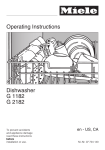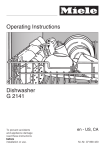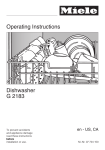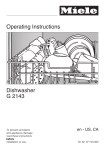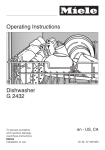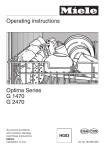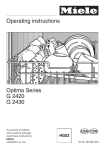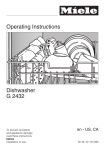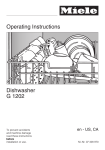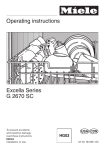Download Miele G2182 Operating instructions
Transcript
Operating Instructions Dishwasher G 1182 G 2182 To prevent accidents and machine damage read these instructions before installation or use. en - US, CA M.-Nr. 07 329 120 Contents IMPORTANT SAFETY INSTRUCTIONS. . . . . . . . . . . . . . . . . . . . . . . . . . . . . . . . . 4 Guide to the dishwasher . . . . . . . . . . . . . . . . . . . . . . . . . . . . . . . . . . . . . . . . . . . . 7 Control panel . . . . . . . . . . . . . . . . . . . . . . . . . . . . . . . . . . . . . . . . . . . . . . . . . . . . . . 8 Caring for the environment . . . . . . . . . . . . . . . . . . . . . . . . . . . . . . . . . . . . . . . . . . 9 Before using for the first time. . . . . . . . . . . . . . . . . . . . . . . . . . . . . . . . . . . . . . . 10 To open the door . . . . . . . . . . . . . . . . . . . . . . . . . . . . . . . . . . . . . . . . . . . . . . . . . . 10 To close the door . . . . . . . . . . . . . . . . . . . . . . . . . . . . . . . . . . . . . . . . . . . . . . . . . . 10 Rinse aid . . . . . . . . . . . . . . . . . . . . . . . . . . . . . . . . . . . . . . . . . . . . . . . . . . . . . . . . 11 Adding rinse aid . . . . . . . . . . . . . . . . . . . . . . . . . . . . . . . . . . . . . . . . . . . . . . . . . . 11 Rinse aid indicator . . . . . . . . . . . . . . . . . . . . . . . . . . . . . . . . . . . . . . . . . . . . . . . . . 11 Adjusting the dosage. . . . . . . . . . . . . . . . . . . . . . . . . . . . . . . . . . . . . . . . . . . . . . . 12 Loading the dishwasher . . . . . . . . . . . . . . . . . . . . . . . . . . . . . . . . . . . . . . . . . . . 13 Items not recommended for dishwashing . . . . . . . . . . . . . . . . . . . . . . . . . . . . . . . 14 Cutlery tray. . . . . . . . . . . . . . . . . . . . . . . . . . . . . . . . . . . . . . . . . . . . . . . . . . . . . . . 15 Upper basket . . . . . . . . . . . . . . . . . . . . . . . . . . . . . . . . . . . . . . . . . . . . . . . . . . . . . 16 Adjusting the upper basket . . . . . . . . . . . . . . . . . . . . . . . . . . . . . . . . . . . . . . . . . . 17 Lower basket . . . . . . . . . . . . . . . . . . . . . . . . . . . . . . . . . . . . . . . . . . . . . . . . . . . . . 18 Basket accessories . . . . . . . . . . . . . . . . . . . . . . . . . . . . . . . . . . . . . . . . . . . . . . . 21 Use . . . . . . . . . . . . . . . . . . . . . . . . . . . . . . . . . . . . . . . . . . . . . . . . . . . . . . . . . . . . 22 Adding detergent. . . . . . . . . . . . . . . . . . . . . . . . . . . . . . . . . . . . . . . . . . . . . . . . . . 23 Turning on . . . . . . . . . . . . . . . . . . . . . . . . . . . . . . . . . . . . . . . . . . . . . . . . . . . . . . . 24 Selecting and starting a program . . . . . . . . . . . . . . . . . . . . . . . . . . . . . . . . . . . . . 24 Program guide . . . . . . . . . . . . . . . . . . . . . . . . . . . . . . . . . . . . . . . . . . . . . . . . . . . 25 Use . . . . . . . . . . . . . . . . . . . . . . . . . . . . . . . . . . . . . . . . . . . . . . . . . . . . . . . . . . . . 26 At the end of a program. . . . . . . . . . . . . . . . . . . . . . . . . . . . . . . . . . . . . . . . . . . . . 26 Interrupting a program. . . . . . . . . . . . . . . . . . . . . . . . . . . . . . . . . . . . . . . . . . . . . . 26 Changing a program . . . . . . . . . . . . . . . . . . . . . . . . . . . . . . . . . . . . . . . . . . . . . . . 26 Additional options . . . . . . . . . . . . . . . . . . . . . . . . . . . . . . . . . . . . . . . . . . . . . . . . 27 Buzzer . . . . . . . . . . . . . . . . . . . . . . . . . . . . . . . . . . . . . . . . . . . . . . . . . . . . . . . . . . 27 Default settings . . . . . . . . . . . . . . . . . . . . . . . . . . . . . . . . . . . . . . . . . . . . . . . . . . . 28 2 Contents Frequently asked questions . . . . . . . . . . . . . . . . . . . . . . . . . . . . . . . . . . . . . . . . 29 Technical faults . . . . . . . . . . . . . . . . . . . . . . . . . . . . . . . . . . . . . . . . . . . . . . . . . . . 29 Problems with water Intake / Drain . . . . . . . . . . . . . . . . . . . . . . . . . . . . . . . . . . . . 31 General problems with the dishwasher . . . . . . . . . . . . . . . . . . . . . . . . . . . . . . . . . 32 Sounds . . . . . . . . . . . . . . . . . . . . . . . . . . . . . . . . . . . . . . . . . . . . . . . . . . . . . . . . . . 33 Poor cleaning results . . . . . . . . . . . . . . . . . . . . . . . . . . . . . . . . . . . . . . . . . . . . . . . 34 Comparison Tests . . . . . . . . . . . . . . . . . . . . . . . . . . . . . . . . . . . . . . . . . . . . . . . . 37 After sales service . . . . . . . . . . . . . . . . . . . . . . . . . . . . . . . . . . . . . . . . . . . . . . . . 40 Transport . . . . . . . . . . . . . . . . . . . . . . . . . . . . . . . . . . . . . . . . . . . . . . . . . . . . . . . 41 User Maintenance Instructions. . . . . . . . . . . . . . . . . . . . . . . . . . . . . . . . . . . . . . 43 Cleaning and Care . . . . . . . . . . . . . . . . . . . . . . . . . . . . . . . . . . . . . . . . . . . . . . . . 44 Triple filter system . . . . . . . . . . . . . . . . . . . . . . . . . . . . . . . . . . . . . . . . . . . . . . . . . 45 Cleaning the spray arms . . . . . . . . . . . . . . . . . . . . . . . . . . . . . . . . . . . . . . . . . . . . 47 Cleaning the water inlet filter . . . . . . . . . . . . . . . . . . . . . . . . . . . . . . . . . . . . . . . . . 48 Cleaning the drain pump and non-return valve . . . . . . . . . . . . . . . . . . . . . . . . . . . 49 Installation instructions . . . . . . . . . . . . . . . . . . . . . . . . . . . . . . . . . . . . . . . . . . . 51 Electrical connection . . . . . . . . . . . . . . . . . . . . . . . . . . . . . . . . . . . . . . . . . . . . . . 52 Plumbing. . . . . . . . . . . . . . . . . . . . . . . . . . . . . . . . . . . . . . . . . . . . . . . . . . . . . . . . 53 Waterproof system . . . . . . . . . . . . . . . . . . . . . . . . . . . . . . . . . . . . . . . . . . . . . . . . . 53 Connection to the water supply . . . . . . . . . . . . . . . . . . . . . . . . . . . . . . . . . . . . . . . 53 Drainage . . . . . . . . . . . . . . . . . . . . . . . . . . . . . . . . . . . . . . . . . . . . . . . . . . . . . . . . 54 3 IMPORTANT SAFETY INSTRUCTIONS WARNING When using your dishwasher, follow basic precautions, including the following: Read all instructions before installation or use of the dishwasher to prevent injury and machine damage. The manufacturer cannot be held responsible for damage or injury caused by improper use of this appliance. Use the dishwasher only for its intended purpose. This appliance is intended for residential use only. Keep these operating instructions in a safe place and pass them on to any future user. 4 Electrical Safety ~ Before installation, make sure that the voltage and frequency listed on the data plate correspond with the household electrical supply. This data must correspond to prevent injury and machine damage. Consult a qualified electrician if in doubt. ~ Before installation or service, disconnect the power supply to the work area by unplugging the unit, "tripping" the circuit breaker or removing the fuse. ~ Do not use an extension cord to connect this appliance to electricity. Extension cords do not guarantee the required safety of the appliance (e.g. danger of overheating). ~ Be certain your appliance is properly installed and grounded by a qualified technician. To guarantee the electrical safety of this appliance continuity must exist between the appliance and an effective grounding system. It is imperative that this basic safety requirement be met. If there is any doubt, have the electrical system of the house checked by a qualified electrician. The manufacturer cannot be held responsible for damages caused by the lack, or inadequacy, of an effective grounding system. IMPORTANT SAFETY INSTRUCTIONS Installation ~ The dishwasher must be installed and connected in compliance with the installation instructions. ~ Installation and repair work should be performed by a Miele authorized service technician. Work by unqualified persons could be dangerous and may void the warranty. ~ , WARNING - Fire hazard Do not cover or crush the plug of the appliance. Ensure that the cabinet opening for the dishwasher provides ample space for the plug. Installing the dishwasher in a tight space may crimp the power cord or put pressure on the plug which could cause overheating. ~ This dishwasher should only be installed under a continuous counter top secured to adjacent cabinetry. ~ Do not install or use a damaged dishwasher. A damaged appliance is dangerous. Unplug the machine and call your Miele dealer or the Miele Technical Service Department. ~ Do not install this dishwasher ~ Ensure that any plastic wrappings, bags, etc. are disposed of safely and kept out of the reach of children. Danger of suffocation! ~ When installing the dishwasher ~ This equipment is not designed for maritime use or for use in mobile installations such as recreational vehicles or aircraft. However, under certain conditions it may be possible for an installation in these applications. Please contact the nearest Miele dealer or the Miele Technical Service Department with specific requirements. ~ It is recommended that the dishwasher only be connected to the mains with the plug (no hard-wiring). The outlet must be accessible at all times after installation to disconnect the dishwasher. beneath a cooking surface, oven or any appliance that radiates heat. High temperatures from these units may damage the dishwasher. under a counter top and removing the toekick, a build-under toekick must be installed. Use the respective installation kit. Danger of injuries. ~ Do not cut the intake hose or submerge it in liquid. This hose contains electrical components that could cause injury or property damage if cut or submerged. ~ Only connect the dishwasher to the mains when all installation and plumbing work is complete. 5 IMPORTANT SAFETY INSTRUCTIONS Use ~ To reduce the risk of injury, do not allow children to play in, on or near the dishwasher. ~ Only use detergents and rinse aids recommended for residential dishwashers. Keep all detergents and rinse aids out of the reach of children. Do not inhale or swallow detergents. ~ Only use the dishwasher if all panels ~ Dishwasher detergents contain irritant are properly in place. ~ Do not tamper with the controls. ~ Do not damage, sit or stand on the door or baskets of the dishwasher. Close the door when not in use. ~ Under certain conditions, hydrogen gas may be produced in a hot water system that has not been used for two weeks or more. HYDROGEN GAS IS EXPLOSIVE. If the hot water system has not been used for such a period, turn on all hot water faucets and let water flow from each for several minutes before using the dishwasher. This will release any accumulated hydrogen gas. Do not smoke or use an open flame during this time. ~ Be sure that all items placed in the dishwasher are "dishwasher safe". For items not labeled, check the manufacturer’s recommendations. ~ When loading tableware, place sharp items away from the door to prevent damage to the seal. Load sharp items pointing downwards to prevent injuries. and corrosive ingredients. They can cause burning in the mouth and throat if swallowed, or inhibit breathing. Consult a doctor immediately if detergent has been swallowed or inhaled. ~ Do not drink water from the dishwasher! Harmful residues could be present. ~ Do not fill the rinse aid reservoir with detergent. It will damage the rinse aid compartment. ~ If the power cord is damaged it must only be replaced by a Miele Service technician with a genuine Miele power cord. Disposal of an appliance ~ If the appliance is removed from its installation site and will not be used, remove the doorlock to the wash cabinet to prevent children from locking themselves in the machine. SAVE THESE INSTRUCTIONS 6 Guide to the dishwasher a Upper spray arm (not visible) g Triple filter system b Cutlery tray h Data plate c Upper basket i Rinse aid reservoir d Middle spray arm j Dual compartment detergent dispenser e Air inlet for drying (depending on model) f Lower spray arm 7 Guide to the dishwasher Control panel a Check / Refill indicators d On button g with Indicator b Program selection e Off button o c Program button 8 Caring for the environment Energy saving washing This dishwasher is exceptionally economical in the use of water and electricity. For best results follow these tips: ^ For lowest energy consumption and the gentlest washing of china and crystal, connect the dishwasher to a cold water source. ^ For fastest possible wash times, yet higher energy consumption, connect the dishwasher to a hot water source. ^ Make full use of the baskets without overloading for the most economical washing. ^ Use the correct amount of detergent and rinse aid. ^ When using powder or gel detergent, reduce the amount to 2/3 of the normal amount when washing a small load. ^ Choose a program that best suits the degree of soiling and the type of dishes being washed. ^ For small loads select "Express". 9 Before using for the first time To open the door To close the door ^ Push the baskets in. ^ Lift the door and push until it clicks into position. ^ Pull the handle to open the door. If the door is opened during operation, the dishwasher will stop running. Once the door is closed the program will continue. 10 Before using for the first time Rinse aid Rinse aid helps to prevent spotting on dishes and glassware. The rinse aid is filled in the reservoir and the set amount will be automatically dosed. ,Filling the rinse aid reservoir with detergent will damage the reservoir. Only pour rinse aid formulated for residential dishwashers into the reservoir. When using "Tab" detergents rinse aid is not needed. Adding rinse aid ^ Pour liquid rinse aid into the reservoir until it is visible on the surface of the screen. The rinse aid reservoir holds approx. 3.7 oz (110 ml). ^ Press on the flap until you hear it click shut. Failure to close it all the way allows water to enter the reservoir during the wash program. ^ Clean any spilled rinse aid. The flap will remain closed during normal operation. Rinse aid indicator When the rinse aid indicator first comes on, there will be enough rinse aid left for 2 - 3 washes. ^ Press the button in the direction of the arrow until the flap springs open. ^ The rinse aid indicator on the control panel will light when the rinse aid reservoir needs refilling. 11 Before using for the first time Adjusting the dosage The dosage selector is preset to 3. This dispenses approximately 3 ml of rinse aid per program. It can be adjusted from 0 to 6. – Use a higher setting if spots appear on dry glassware. ^ Use a lower setting if streaking appears on dishes or glasses. ^ Turn the dishwasher off "V". ^ Press and hold the "Program" button and at the same time turn the dishwasher on g. Hold the "Program" button until the indicator comes on. If it does not come on start over. The amount set can be recognized by the flashing rhythm of the "SaniWash" indicator (see table): Dosage in ml Flashing rhythm 0 - 1 Once 2 Twice 3 3 times 4 4 times 5 5 times 6 6 times ^ Press and hold the "Program" button until the "Intake / Drain" indicator lights up. ^ Press the "Program" button three times. ^ Select the desired setting with the "Program" button. Every touch of the button increases the level. The "Intake / Drain" indicator flashes three times in intervals. The programmed dosage is saved. The "SaniWash" indicator flashes 3 times in intervals. The rinse aid dosage is adjusted to 3 ml by default. 12 ^ Turn the dishwasher off "V". Loading the dishwasher ,Do not wash items soiled with ash, sand, wax, grease or paint in the dishwasher. Ash and sand do not dissolve and will be distributed throughout the inside of the dishwasher. Wax, grease and paint will cause permanent discoloration and damage to the dishwasher. ^ Scrape food from dishes before placing them in the dishwasher, rinsing is not necessary. ^ Some foods contain natural dyes, e.g. carrots or tomatoes. Plastic items may discolor permanently if they come in contact with food dyes. ^ The spray arms must not be blocked by items that are too tall or hang through the baskets. Check clearance by manually rotating the spray arms. ^ Place very small items in the cutlery tray or basket so they do not fall to the bottom of the wash cabinet. ^ Food residue and spilled liquids should be cleaned from the sides of the dishwasher door. These are outside of the wash cabinet and are not cleaned by water from the spray arms. ^ All items can be placed anywhere in the baskets. ^ Load dishes so that water can reach all surfaces. Do not place dishes or cutlery inside other pieces. ^ Make sure that all items are securely positioned. ^ Hollow items such as cups and glasses should be placed upside down in the baskets. ^ To ensure good water coverage, tall, narrow and hollow items, i.e. vases or champagne glasses, should be placed in the center of the basket rather than in the corners. ^ Concave based items such as mugs or bowls, should be placed at an angle so that water does not pool. 13 Loading the dishwasher Items not recommended for dishwashing – Cutlery with wooden handles – Wooden cutting boards – Glued items such as old knives with handles glued together around the shank of the blade – Handmade craft items, antique, metal trimmed or decorative glassware – Plastic items that are not heat resistant – Copper, brass, tin or aluminum – Dishes with color painted over the glaze. These dishes may fade over time – Cast iron pots and pans * depending on model Glassware: – There are no standard guidelines for washing glassware, when in doubt wash by hand. – When purchasing new dishes, glasses and cutlery, make sure they are dishwasher safe. Only wash items marked "dishwasher safe" in the dishwasher. Silver and aluminum: – Silver or aluminum items may tarnish. – Silverware previously cleaned with a silver polish may be damp or spotted at the end of a program where water has adhered to the polish. This can be rubbed off with a soft, dry cloth. Silver that has been cleaned in an immersion dip is usually dry at the end of a program, but may tarnish. – If left to dry, foods containing sulfur can discolor silver. These include egg yolk, onions, mayonnaise, mustard, fish and marinades. – Silverware may tarnish or pit if washed next to stainless steel. Leave space between these metals. – Clean aluminum items, e.g. grease filters, with domestic dishwasher detergent only. 14 Loading the dishwasher Cutlery tray ^ Arrange the cutlery as shown in the cutlery tray. Spoons with thick handles may have to be placed as knives and forks with their heads in the holders. For easier unloading cutlery should be grouped in zones, one for knives, one for forks, one for spoons, etc. Place knives with the cutting edge down and forks with the prongs between the holders. Spoons should be placed in the opposite direction with the handles between the holders so that water can run off more easily. The upper spray arm must not be blocked by tall cutlery items. The cutlery tray insert is removable. 15 Loading the dishwasher Upper basket ,Always use the dishwasher with Coffee bar (depending on model) the upper and lower basket inserted. Glasses can be leaned against the coffee bar for a secure stand. ^ Load the upper basket with small, lightweight, or delicate items such as cups, saucers, glasses, dessert bowls and flat pans. ^ Long items such as soup ladles, mixing spoons and long knives should be placed lying down across the front of the upper basket. 16 ^ The bar can also be used to separate two rows of glasses. To stack wide items, flip the bar to the right. Cup racks Raise the rack to make room for tall glasses. Lower it to double stack smaller pieces. Loading the dishwasher Adjusting the upper basket The upper basket can be raised or lowered to accommodate tall items. The basket can also be angled to fit tall items in both, the upper and lower baskets. The angles should not be set to opposite extremes. This will block the middle spray arm. Take care when sliding the basket in and out in this position. Depending on the setting of the upper basket, a variety of plate dimensions can be accommodated. For example: If the upper basket is in its highest position a plate with a diameter of 12 3/16" (31 cm) can be fit in the lower basket. ^ Slide out the upper basket. ^ Pull up the levers at the sides of the upper basket and adjust the basket height. ^ Release the levers and the basket will lock in place. 17 Loading the dishwasher Lower basket Foldable spikes ^ For larger and heavier items such as plates, serving platters, saucepans, bowls, etc. Small plates and saucers can also be arranged in the lower basket. The foldable spikes can be used for small plates and saucers. Two rows of spikes can be folded down, to create more room for larger dishware, e.g. pots, pans and bowls. ^ Press the yellow lever down a and fold down the spikes b. 18 Loading the dishwasher Removable spike insert The spike insert can be removed in order to make room for larger tableware or to use a different insert. Removeable PlateGuard Plus with StemGuard (depending on model) Removing the insert This insert is ideal for cups, glasses, plates, bowls, pots and pans. ^ To remove the insert, gently pull the handle upwards. ^ To arrange tall items the cup rack can be raised. Replacing the insert b ^ Slide the hitches of the insert under the struts of the lower basket. ^ The stemguard can be used to hold the stems of glassware or coffee cup handles. ^ Push down on the handle to snap the insert into position. 19 Loading the dishwasher Vase / Bottle insert (depending on model) Removing the insert a: ^ To remove the insert, gently pull the handle upwards. Inserting the insert b: ^ Place the insert into the lower basket. ^ Slide the hitches of the insert under the struts of the lower basket. ^ Push down on the handle to snap the insert into position. 20 The vase / bottle insert can be used to rinse narrow items, e.g. vases, baby bottles, etc. ^ Place the insert into the lower basket as shown in the illustration. If placed anywhere else, water will not reach all surfaces. The item will not be properly cleaned. Basket accessories Additional inserts for the upper and lower baskets may be purchased from your Miele dealer or Miele. Depending on the model some accessories come standard with the machine. Glassware insert GGO To wash long stemmed glassware attaches to the upper basket Multi-function basket GMFO To wash saucers, baby bottles and small items Cappuccinatore insert GCEO To wash the parts of the Cappuccinatore Tall glassware insert GGU To wash tall glassware in the lower basket Large diameter plate insert GTLU 35 To wash large plates with a maximum diameter of approx. 13 3/4" (35 cm). 21 Use Detergent ,Dishwasher detergents contain irritant and corrosive ingredients. Avoid inhaling or swallowing dishwasher detergent. Keep children away from detergent. Fill the detergent dispenser only when you are ready to start the dishwasher. ,Only use detergents formulated for domestic dishwashers. Use only the recommended amount of detergent. Continued use of too much detergent may cause machine damage. 22 You can use powder, gel or tab detergents. Follow the dosage information on the detergent packaging. Detergent tabs are not recommended for use with the program "Express". The tabs may not dissolve completely. Dishwasher cleaning products are available from MIele. Use Adding detergent ^ To open, press the latch on the detergent dispenser. The flap will spring open. The flap is always open at the end of a program. ^ Use one tab or add powder or gel detergent to compartment II and close the flap. ^ If a Pre-rinse is desired, and available for your chosen program, add 1 teaspoon (5 ml) of detergent to compartment I. The horizontal marks in compartment II indicate the levels of approximately 1 ¼ and 2 tablespoons (20 and 30 ml) respectively. Compartment I holds a maximum of 2 teaspoons (10 ml). 23 Use Turning on ^ Open the water supply, if closed. ^ Open the door. ^ Make sure the spray arms can rotate freely. ^ Turn the dishwasher on "g". The "g" indicator lights up. Selecting and starting a program Choose your program according to the type of load and soiling. See the "Program Guide" for more information. ^ Select the desired program with the "Program" button. The program indicator of the selected program lights. ^ Start the program by closing the door. Cancel a program only in the first few minutes. Otherwise important program steps may be interrupted. 24 Program guide Program When to use Program sequence Prerinse 1 Main wash 2 1 Pots & Pans For normally soiled pots and pans with dried on food, also for heavily soiled dishware, use 120% of normal detergent amount Normal For normally soiled dishware Economy For normally soiled dishware, energy saving program with a long soaking time and a low temperature x SaniWash Extended wash time, for sanitizing normally soiled dishware with dried on food x Express "Quick program" for lightly soiled dishware, e.g. party dishware includes sensor controlled Glasscare, not suitable for detergent tabs x Rinse & Hold To rinse dishes when a complete program is not needed detergent is not recommended x x x Interim rinse Drying x x x x x x x x x x 2 x x x x x Final rinse x Usage: Electric: 0.01 - 1.23 kWh Water: 1.3 - 5.0 gal (5 - 19 l) 25 Use At the end of a program Interrupting a program ^ Open the door a few inches to see if the program has finished. A program is interrupted as soon as the door is opened. If the door is closed, the program will continue from where it was interrupted. The indicator of the selected program has gone out. If the program indicator is still on, the program is still running. Close the door again to allow the program to finish. Keep the door open slightly. The dishes will cool much faster. ^ Unload the dishwasher. Unloading the lower basket first will prevent water drops from the upper basket and cutlery tray (depending on model) from dropping onto dishes in the lower basket. ^ Turn the dishwasher off "V". The dishwasher continues to use electricity until turned off with the "o" button. If the dishwasher is not used for a longer period of time, e.g. vacationing, turn off the water supply. 26 ,Open the door with care. The water in the dishwasher is hot. Danger of scalding. Before closing the door again, leave it ajar for approx. 20 secs. This will enable the temperature in the wash cabinet to settle. Close the door firmly until it clicks into place. Changing a program If the detergent flap is already open, do not change the program. If a program has already started and you wish to change it: ^ Open the door. ^ Press the "o" button. ^ Press the "g" button. ^ Select the desired program with the program button. ^ Start the program by closing the door. Additional options Buzzer A signal sounds at the end of a program and when a fault occurs. The buzzer at the end of a program sounds five times in quick succession for up to one hour. ^ Press the "Program" button four times. The "Intake / Drain" indicator flashes four times in intervals. The setting can be recognized by the flashing of the "SaniWash" indicator: The buzzer for a fault sounds continuously for up to two minutes. – flashing: buzzer is activated The buzzer is activated by default. It can be turned off, so it does not sound at the end of a program. The buzzer for a fault cannot be turned off. ^ To change the setting press the "Program" button for at least one second, until the "Intake / Drain" indicator lights up. ^ Open the door. ^ Turn the dishwasher off with "o". ^ Press the "Program" button and at the same time turn the dishwasher on with "g". – not lit up: buzzer is deactivated ^ Press the "Program" button. The setting is saved. ^ Turn the dishwasher off "o". ^ Hold the program button until the "Rinse & Hold" program indicator comes on. If it does not come on, start over. 27 Additional options Default settings All settings can be reset to the factory default. ^ Open the door. ^ Turn the dishwasher off "o". ^ Press and hold the "Program" button and at the same time turn the dishwasher on "g". Hold the "Program" button until the "Rinse & Hold" program indicator comes on. The setting can be recognized by the flashing of the "SaniWash" indicator: – flashing: all settings are factory default – not lit up: at least one setting was changed ^ To change the setting press the "Program" button for at least one second, until the "Intake / Drain" indicator lights up. ^ Press the "Program" button. If it does not come on, start over. The setting is saved. ^ Press the "Program" button 12 times. ^ Turn the dishwasher off "o". The "Intake / Drain" indicator flashes once long and twice short in intervals. 28 Frequently asked questions With the aid of the following guide, minor problems can be fixed without a service call. Repairs should only be carried out by a qualified and trained person in accordance with local and national safety regulations. Unauthorized repairs could cause personal injury or machine damage. Technical faults Problem The program does not start. The dishwasher stops during a program. Possible fault The door is not properly closed. The machine is not plugged in. Solution Close the door firmly. The fuse is defective or the breaker has tripped. Reset the circuit breaker. See data plate for minimum amperage. The dishwasher is not turned on. Turn the dishwasher on "g" and select a program. The fuse has tripped. Reset the circuit breaker. See data plate for minimum amperage. Insert the plug. 29 Frequently asked questions Problem Possible fault Solution The buzzer sounds. All program indicators are flashing fast when the door is open. There may be a technical fault. Turn the dishwasher off "o". After a few seconds: – Turn the dishwasher on. – Select the desired program with the program button. – Close the door. If the problem persists contact Technical Service. The drain pump is The waterproof system running when the door has activated. is opened. 30 – Turn off the water supply. – Contact Miele Technical Service. Frequently asked questions Problems with water Intake / Drain Problem Shortly after the program start the dishwasher stops running. The buzzer sounds. The Intake / Drain indicator flashes when the door is open. The dishwasher stops. The buzzer sounds. The "Intake / Drain" indicator flashes when the door is open. Possible fault The water supply is shut off. Solution – Open the water supply. Before fixing the fault: – Turn the dishwasher off "o". Fault in the water intake. Fault in the water drain. There may be water in the wash cabinet. – Open the water supply all the way. – Clean the water intake filter, see "User Maintenance Instructions". – The water pressure at the water connection is lower than 4.35 psi. Consult a plumber. – Clean the triple filter. – Clean the drain pump and the non-return valve. See "User Maintenance Instructions" for more info on the above. – Remove any kinks in the drain hose. 31 Frequently asked questions General problems with the dishwasher Issue Detergent is left in the dispenser at the end of a program. The detergent lid cannot be closed properly. The door and the interior walls are still wet after a program has finished. Water remains in the wash cabinet at the end of a program. Possible fault Solution The dispenser was damp Dry the dispenser before when detergent was added. adding detergent. Detergent residue is blocking the catch. This is not a fault! The moisture will It is the normal operating evaporate after a short mode of the drying system. time. The triple filter in the wash cabinet is clogged. The drain pump or the non-return valve may be blocked. The drain hose is kinked. 32 Remove the residue. Before fixing the fault: – Turn the dishwasher off "o". Clean the triple filter. See "User Maintenance Instructions". Clean the drain pump and the non-return valve, see maintenance instructions. Remove any kinks from the drain hose. Frequently asked questions Sounds Problem There is a knocking noise in the wash cabinet. There is a rattling noise in the wash cabinet. There is a knocking noise in the water pipes. Possible fault Solution The spray arm is hitting an Interrupt the program, item in the basket. rearrange items blocking the spray arms. Items are not secure in the Interrupt the program and wash cabinet. rearrange loose pieces. This may be caused by This has no effect on the the installation or the dishwasher. If in doubt diameter of the pipe. contact a plumber. 33 Frequently asked questions Poor cleaning results Problem Possible fault The dishes are not The dishes were not loaded clean. correctly. The program was not powerful enough. Not enough detergent was dispensed. The spray arms are blocked by items. The triple filter in the base of the wash cabinet is not clean or not correctly inserted. The spray arm jets might be clogged. The drain pump or the non-return valve is blocked. Wash water will run back into the wash cabinet. Glasses and cutlery show streaks. There is a bluish sheen on the surface of glasses and a film that can be wiped off. 34 The rinse aid dosage is set too high. Solution See "Loading the dishwasher". Select a more intensive program, see "Program Guide". Use more detergent, see "Adding detergent". Turn the spray arm and rearrange the dishes if necessary. Clean the filter and insert it correctly. Clean the spray arm jets. See "User Maintenance Instructions". Clean the drain pump and the non-return valve, see maintenance instructions. Reduce the dosage, see "Before using for the first time". Frequently asked questions Problem Possible fault Solution Dishes are still wet, glasses and cutlery are spotted. The rinse aid setting may be too low, or the rinse aid reservoir is empty. Increase the dosage, refill the reservoir or switch the rinse aid product when refilling, see "Before using for the first time". Dishes were taken out too Leave dishes in longer, soon. see "Use". A "Tab" product was used. These products have a low drying effect. White residue is visible on cutlery and dishes. Clouding occurs on glassware and film can be wiped off. Use a normal (powder or gel) detergent and add rinse aid. Not enough rinse aid was Increase the dosage, see used. "Before using for the first time". A "Tab" product was used. Use a normal (gel or powder) detergent. 35 Frequently asked questions Problem Possible fault Glasses are discolored and the film cannot be wiped off. Glasses are dull and discolored, film cannot be wiped off. Detergent ingredients have Use a different detergent. been deposited on the glassware. Tea or lipstick stains have not been completely removed. The wash temperature of the selected program was too low. The detergent has a low bleaching effect. Natural dyes e.g. from vegetables may be the cause. Not enough detergent was used to break down natural dyes. The affected items are not corrosion resistant. Plastics are discolored. There are rust stains on cutlery. 36 Glasses are not dishwasher safe. Solution There is no remedy. Only wash dishwasher safe glasses in the dishwasher. Select the "Economy" or "SaniWash" program. Use a different detergent. Use more detergent, see "Adding detergent". Discoloration is permanent. There is no remedy. Only wash dishwasher safe cutlery in the dishwasher. Comparison Tests 10 place settings, Standard program: Normal Upper basket Lower basket Cutlery tray 37 Comparison Tests 12 place settings, Standard program: Normal Upper basket Cutlery tray 38 Lower basket Comparison Tests 14 place settings, Standard program: Normal Upper basket Lower basket Cutlery tray 39 After sales service Repairs MieleCare In the event of a fault which you cannot correct yourself please contact the Miele Service Department at the phone number on the back of this booklet. (USA only) ^ Please quote the model type and number of your appliance. These can be found on the data plate along the right edge of the door. PC Update The Program Correction (PC) allows a technician to update the dishwasher to make use of new technology. When, for example, technological developments offer advanced modifications to your existing program cycles a service technician will be able to input these into your machine controls via the indicator light marked PC. Miele will provide information when such possibilities become available. MieleCare, our Extended Service Contract program, gives you the assurance of knowing that your appliance investment is covered by 5 years of worry free ownership. MieleCare is the only Extended Service Contract in the industry that guarantees repairs by a Miele Authorized Service Provider using genuine Miele parts. Only genuine Miele parts installed by factory trained professionals can guarantee the safety, reliability, and longevity of your Miele appliance. Please note that unless expressly approved in writing by Miele’s Service department, Extended Service Contracts offered by other providers for Miele products will not be recognized by Miele. Our goal is to prevent unauthorized (and untrained) service personnel from working on your Miele products, possibly doing further damage to them, you and/or your home. To learn more about MieleCare Extended Service Contracts, please contact your appliance dealer or visit us online at: http://miele.com/mielecare 40 Transport To transport the dishwasher, e.g. when moving to a new home, note the following: – Empty the dishwasher. – Secure any loose parts, e.g. hoses, cables, cutlery baskets. – Transport the dishwasher in the upright position. If unavoidable it may be transported on its back. Do not transport it on its side or on the door. Residual water in the machine could leak and cause electrical damage. 41 42 User Maintenance Instructions To prevent accidents and machine damage, read these instructions before installation or use. Cleaning and Care Exterior Check and clean your dishwasher regularly (approx. every 4-6 months). This will help avoid faults and problems. ^ Only use a conditioner suitable for your kitchen cabinetry. ,Abrasive cleaning agents, glass ^ Clean the front with a solution of warm water and liquid soap applied with a soft sponge. Dry with a soft cloth. cleaning agents, all-purpose cleaners, thinner or ammonium cleaners should not be used on the dishwasher. They will damage the surface. Wash cabinet Generally, the wash cabinet is self cleaning if the correct amount of detergent is used. ^ Clean wood with a damp cloth and wipe dry. To prevent damage to your appliance avoid the following: – cleaners containing soda, ammonia, thinners, or chlorides – cleaners containing descaling agents, The wash cabinet can be cleaned with a dishwasher cleaner such as "Dis Cleaner" available from your Miele dealer, Miele or online at www.miele.com. – abrasive cleaners, Door and the door seal – glass cleaners, ^ Wipe the door seals regularly with a damp cloth to remove food deposits. – scouring pads, steel wool, hard brushes, ^ Food residue and spilled liquids should be wiped from the sides of the dishwasher door. These are outside of the wash cabinet and are not cleaned by water from the spray arms. – metal scrapers – stainless steel cleaners, – dishwasher soap (powder), – caustic (oven) cleaners, Control panel ^ The plastic control panels should only be wiped with a damp cloth or suitable cleaning agent designed for use on plastic. ,The appliance and front controls are not scratch proof. Remove spills immediately. 44 Cleaning and Care Triple filter system The triple filter system in the base of the wash cabinet prevents food from being redeposited on dishes. It also protects the circulation pump from damage caused by foreign objects (e.g. broken glass, bones). ,The machine must not be used without all the filters in place! ^ Check and clean the filter system regularly or whenever a foreign object is trapped. The level of soiling and time it takes before the filters need cleaning will vary depending on your household usage. ^ Turn off the dishwasher before cleaning. ^ Turn the handle counterclockwise to release the triple filter system a. ^ Lift the filter combination out of the machine b. Remove any solid particles and rinse under running water. Scrub with a nylon brush if necessary. 45 Cleaning and Care To clean the inside of the filter, the flap must be opened. ^ Return the filter so it lies flat in the base of the wash cabinet. ^ Push the clips together a and open the flap b. ^ Lock the filter by turning the handle clockwise. ^ Rinse under running water. ^ Close the flap so that the clip engages. 46 ,The triple filter system must be inserted and locked into place. Large particles could get in the circulation system and cause a blockage. Cleaning and Care Cleaning the spray arms Sometimes particles of food get stuck in the spray arm jets. The spray arms should be inspected and cleaned every 4 - 6 months. ^ Turn off the dishwasher before cleaning. Removing the spray arms ^ Remove the cutlery tray (if present). ^ Push the upper spray arm up to engage the inner ratchet and unscrew the spray arm. ^ Lift up the middle spray arm, a, to engage the ratchet and unscrew the spray arm, b. ^ Remove the lower basket. ^ Pull the lower spray arm firmly upwards to remove. ^ Use a pointed object such as a toothpick to push food particles into the spray arm jets. ^ Rinse thoroughly under running water. ^ Return the spray arms and check that they rotate freely. 47 Cleaning and Care Cleaning the water inlet filter A filter is incorporated into the intake hose attached to the dishwasher’s shut off valve. If your water is hard or the pipes contain sediment, this filter may clog and prevent enough water from entering the wash cabinet. ,The plastic housing of the water connection contains electrical wiring. Do not cut the intake hose or submerge it in liquid. Installing an in-line water filter If your water contains a large number of insoluble substances, a filter between the water valve and the intake hose connection is recommended. These filters can be purchased from Miele. Cleaning the filter ^ Turn off the dishwasher and pull the plug. ^ Turn off the water supply. ^ Unscrew the intake hose. 48 ^ Carefully remove the rubber seal. ^ Remove the filter using needle nose pliers and rinse it under running water. ^ Reinsert the filter and seal. Make sure they are seated correctly. ^ Screw the intake hose back on the water valve, checking that it is not cross-threaded. ^ Slowly turn on the water supply and test for leaks. Cleaning and Care Cleaning the drain pump and non-return valve If the dishwasher is not completely drained at the end of a program, the drain pump or non-return valve may be blocked. ^ Turn off the dishwasher and pull the plug. ^ Remove the triple filter (see "Triple filter system"). ^ Use a cup or bowl to scoop water out of the wash cabinet. The drain pump is beneath the non-return valve (see arrow). ^ Remove all foreign objects from the drain pump (glass or bone splinters). ^ Before returning the non-return valve, check that the drain pump is not blocked. Spin the propeller several times in both directions to check for obstructions. ^ Carefully reinsert the non-return valve and secure it with the locking clamp. ^ Tilt the locking clamp to the side a. ,Make sure the locking clamp clicks into place! ^ Pull out the non-return valve b and rinse it under running water. ^ Remove all foreign objects from the non-return valve. 49 50 Installation Instructions For installation of the dishwasher please refer to the Installation Sheet supplied with these instructions. Electrical connection ,Installation, repairs and other work by unqualified persons could be dangerous. The manufacturer cannot be held responsible for unauthorized work. Check that the voltage, frequency and fuse rating shown on the data plate match the household mains supply. The power outlet must be accessible after installation. Do not use an extension cord to connect the dishwasher to the mains. Danger of overheating! See data plate on the right side of the door. A damaged power cord must only be replaced with a genuine Miele cord by a Miele service technician. GROUNDING INSTRUCTIONS THIS APPLIANCE MUST BE GROUNDED. In the event of a malfunction or breakdown, grounding will reduce the risk of electric shock by providing a path of least resistance for the electrical current. This appliance is equipped with a cord having an equipment grounding conductor and a grounding plug. The plug must be plugged into an appropriate outlet that is installed and grounded in accordance with all local codes and ordinances. 52 ,Improper connection of the equipment grounding conductor can result in electric shock. Do not modify the plug provided with the appliance; if it will not fit the outlet, have a proper outlet installed by a qualified electrician. If there is any question concerning the proper electrical connection or grounding of this appliance to the power supply, please consult a licensed electrician or call Miele’s Technical Service Department: U 1-800-999-1360 V 1-800-565-6435 Specifications The dishwasher comes equipped with a 4 ft (1.2 m) power cord with a molded plug for connection to 120 V, 60 Hz, 15 A grounded receptacle. Plumbing Waterproof system All Miele dishwashers have a safety valve located on the incoming water line and a sealed underside with a water sensor. If a fault occurs, the water intake is stopped and the drain pump is activated. Water damage, if any, is minimized. Providing the dishwasher was installed correctly by a Miele technician, the waterproof system will protect you from water damage throughout the lifetime of the machine. – The water inlet hose comes equipped with a 3/4" female hose thread connector. This can be directly connected to a water supply with 3/4" MHT (male hose thread ends). – Water pressure: Must be between 4.5 - 145 psi (0.3 - 10 bar). ,To prevent damage to the dishwasher, it must only be connected to a fully vented drainage system. Connection to the water supply ,Do not drink water from the dishwasher! – The dishwasher can heat its own water to the temperature required by the wash program. This allows for connection of the machine to either a hot or cold water source. For lowest energy consumption connect the dishwasher to a cold water source. For fastest possible wash times, with slightly higher energy consumption, connect the dishwasher to a hot water source. All programs use hot water in the rinse cycles. – The inlet hose is approximately 5 ft. (1.5m) long. A 5 ft. (1.5m) extension hose is available from Miele. ,Do not cut the intake hose. It contains electrical wiring. If the hose is cut, the dishwasher will not work. There will be a water leak and you could be injured. If the hose is too long, coil it neatly and place it behind the machine. 53 Plumbing Drainage Venting the drainage system – The machine comes equipped with a built-in non-return valve on the discharge side to prevent waste water from flowing back into the dishwasher. If the dishwasher drain hose is connected to a floor drain or to a drain pipe that is less than 8" (20 cm) above the floor, the drain must be vented. Otherwise the water inside the dishwasher may siphon out during the wash program. – The dishwasher is equipped with a 5 ft (1.5 m) flexible drain hose with an internal diameter of 7/8" (22 mm). – Drain hose extensions and adapters can be ordered from Miele. The maximum drain hose length is 13 ft. (4 m), max. drain height: 39" (1 m). ^ Open the dishwasher door and remove the lower basket. ^ Pull the lower spray arm firmly upwards to remove. – If the hose is to be directly fitted to the drainage outlet on site, use the supplied hose clip (see assembly plan). – The hose can be installed to the left or right side. – The existing drain pipe for the drain hose is designed for various hose diameters. The drain pipe must be shortened if the drain pipe extends too far into the drain hose. The drain hose could get clogged. – The drain hose must not be shortened. ,Make sure the hose is installed without kinking, pressure or being pulled. 54 ^ Cut off the vent cap located at the right rear of the triple filter system, as illustrated. 55 Alterations reserved/4308 G1182/G2182 For the most updated manual see the Miele web site. M.-Nr. 07 329 120 / 02
























































